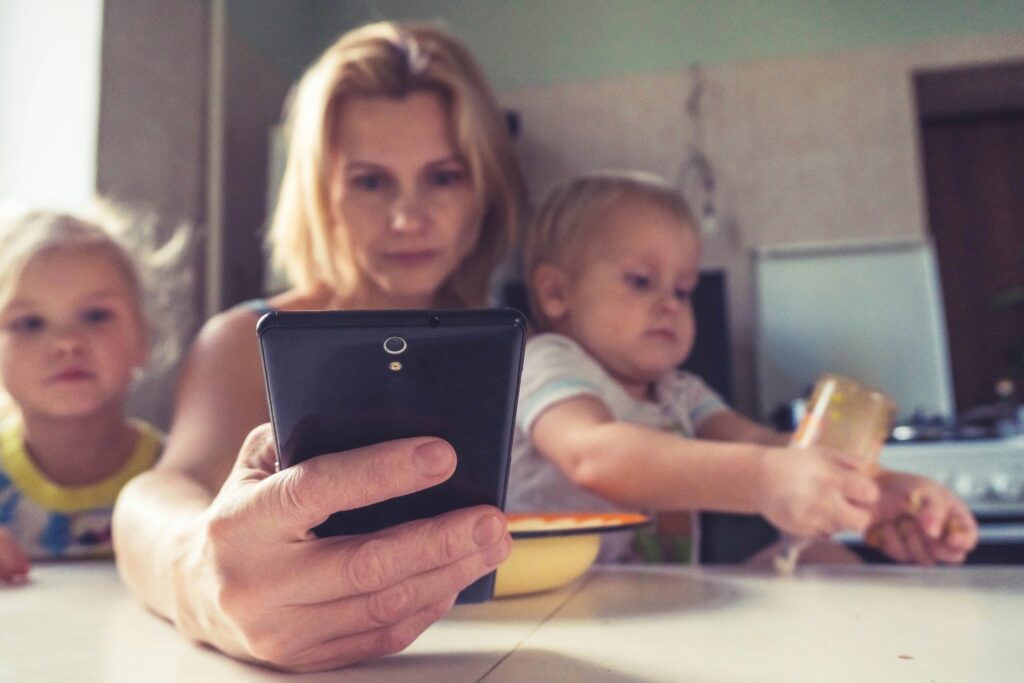How we talk about food and bodies with our children can have a significant impact on their self-perception and relationship with eating. Through these conversations, we can help support children in having a balanced relationship with food and their bodies.
Eating disorders are complex mental illnesses that affect one’s eating behaviors, and they can affect people of all ages. Some eating disorders are characterized by a drive to change how one looks due to a distorted body image. Body image refers to how we perceive, think, and feel about our bodies. It can encompass our beliefs about our appearance, how we feel in our own skin, and how we think others view us.
By talking to children about food and body image, we can promote self-acceptance, change the focus away from appearance, and create an environment where children feel safe to express their concerns.
An Uphill Battle
In our society, we are surrounded by constant scrutiny on our eating behaviors and body size. It’s a culture that tells female-identifying individuals they need to constantly improve their looks and try the new weight loss trend or diet, yet simultaneously criticizes them for being “too sexy.” It’s a culture that tells male-identifying individuals they need to look more masculine, bigger, and leaner. It’s a culture that doesn’t fully accept trans bodies and nonbinary identities. It’s a culture that disproportionately oppresses Black and Brown bodies for looking different, while those same racial inequalities create food deserts that limit access to healthy and affordable food options.
This culture can make it difficult to navigate our relationships with our bodies as adults. It can feel scary or disheartening to know the children in our lives are exposed to the same pressures. However, it’s also an opportunity: a chance to shift the narrative about food and bodies. Instead of hiding the challenge or struggle, we can talk about it openly and practice new ways of interacting with food and body image.
Be Alert to Body Image Concerns
Throughout this blog, we’ll mostly focus on proactive tips to talk to your children. But it’s also important to be on the lookout for signs of distress. It’s normal for children to be curious about their bodies, but it’s important to be aware of when this curiosity becomes intense, obsessive, or critical. These patterns can potentially lead to disordered eating behaviors, eating disorders, or other mental health conditions. Here are some signs to watch for:
- Talking Negatively About Their Bodies: If a child frequently makes negative comments about their appearance, it can be a red flag. Pay attention to statements that reflect dissatisfaction or self-criticism about their body.
- Comparing Their Bodies to Others: Children who constantly compare their bodies to their peers or to images they see in the media may be struggling with body image issues. This comparison can lead to feelings of inadequacy and low self-esteem.
- Avoiding Activities: Notice if a child avoids a physical activity because they think their body won’t be able to handle it or because they don’t want others watching them. This avoidance can be a sign of underlying body image concerns.
- Expressing Guilt Around Food: Be alert if a child expresses guilt about eating certain foods, avoids favorite foods, or talks about dieting. These behaviors can indicate an unhealthy relationship with food and a preoccupation with body weight or shape.
Recognizing these signs early can help caregivers intervene and support children in developing a positive body image and relationship with food.
Saying it Directly: Acknowledging the Challenges of Body Image
We know you want to keep your child’s world filled with sunshine and rainbows, but ignoring the challenges of body image is often not helpful. Addressing these issues directly can validate the experiences young people have and provide them with tools to navigate the world more confidently.
Break Down the Myths:
Children and adolescents are constantly absorbing cultural messages about body norms and what the “perfect body” looks like, often without realizing it. By directly acknowledging that culture wants to control what bodies should look like, we can help them understand that these norms are unrealistic and often harmful. Encourage the belief that bodies shouldn’t be perfect; they should be unique to each person. Celebrate diversity in body shapes and sizes, emphasizing that all bodies are good bodies.
Addressing Social Media
Don’t ignore what children might be seeing on social media. It’s a powerful influence that can shape their perceptions of beauty and body image. Instead of avoiding the topic, engage with them about what they’re viewing. Discuss the reality behind curated images, filters, and editing. Help them understand that what they see online is often not a true reflection of real life. This doesn’t always have to be a serious conversation, but it’s important to create an open dialogue where they feel comfortable sharing their thoughts and feelings.
Tips for Talking About Serious Topics with Children:
- Be Honest and Age-Appropriate: Use language and concepts that match their level of understanding.
- Listen Actively: Encourage them to share their thoughts and feelings without judgment.
- Validate Their Feelings: Let them know it’s okay to feel confused, upset, or frustrated about these topics.
- Use Examples: Share relatable stories or scenarios from what you’ve experienced. Being a bit vulnerable about the pressures around food and their physical appearance can help children feel like their experiences are normal.
- Stay Positive: Reinforce positive messages about self-worth and body acceptance.
By directly acknowledging the challenges of body image and fostering a positive or neutral relationship with food, caregivers and family members can help children navigate these complex issues with confidence.
Discussion Around the Dinner Table
Children are growing, and getting a balanced and nutritious diet is incredibly important (just as it is for adults too!). One way to nurture a less charged relationship with food is to take the judgment out of it.
Encourage intuitive eating, which means being attentive to your body’s cues around hunger and satiation. While this is easier said than done, it can be taught or rather, retaught. Interestingly, we all start with intuitive eating. Babies eat when they’re hungry and stop when they’re full. It’s only when children start learning cultural and adult ways of eating that they move away from this intuitive framework.
We understand that schedules are important and there are reasons for fitting meals into a routine. However, what’s crucial is that the body’s signals should take precedence over these schedules. If a child is hungry outside of mealtimes, offer a snack! If they aren’t that hungry during mealtime, there’s no shame in that either.
By modeling a positive relationship with food and promoting intuitive eating, caregivers can help children develop a healthier approach to eating and body image. This shift can lead to a more balanced and less stressful interaction with food.
The Importance of Modeling
Having open conversations about food and body image is crucial, but it’s just as important to lead by example. Show the behaviors you hope your children will adopt by practicing them yourself. Your actions speak volumes and can have a profound impact on how your children perceive and treat their own bodies
Young children are significantly influenced by what they see in the world around them, including social media and other external sources. However, they are perhaps most influenced by the direct people in their lives. If children observe their parents or caregivers dieting and speaking negatively about their own bodies, they are likely to imitate those insecurities.
Conversely, the opposite is also true: when a child sees their parents or caregivers showing love and grace for their bodies, they will internalize those more body-positive messages. Embrace your position as a role model by demonstrating a healthful relationship with food and body image.
Empathize with the Challenges
Modeling body positivity or neutrality and fostering a healthy relationship with food won’t always be easy, and you won’t be able to seize every opportunity for a productive discussion with your child. As parents, caregivers, teachers, and others involved in children’s lives, you will make mistakes. However, the most important part is to empathize and be honest.
How to Respond to a Child Who Brings Up Body Insecurities
When a child brings up concerns about eating or their body, take a moment to recognize the significance of this act. It’s a huge display of trust for a child to share something vulnerable with you. Effective and empathetic listening is key here.
- Acknowledge Their Feelings: Let the child know that their feelings are valid. Acknowledge that these challenges are real and that it’s okay to feel this way.
- Share Your Own Experiences: If appropriate, share a personal story about how you’ve struggled with body dissatisfaction or a negative body image. This helps normalize their feelings and shows them that they are not alone.
- Offer Reassurance and Support: Reinforce that they are loved and valued just the way they are. Emphasize the importance of health and well-being over appearance.
- Encourage Open Dialogue: Create a safe space for ongoing conversations. Let them know they can always come to you with their concerns.
Empathizing with children’s challenges and responding with honesty and support can help them feel understood and less alone in their struggles. This approach not only strengthens your bond with them but also empowers them to navigate these issues with resilience.
Find Support with The Alliance
Talking to children about food and body image is essential in helping them develop a healthy relationship with their bodies and with eating. By addressing these topics directly, modeling positive behaviors, and showing empathy, you can empower your children to navigate the complex cultural messages they encounter every day. Remember, it’s okay to make mistakes along the way—what matters most is your commitment to creating an open and supportive environment.
If you find it challenging to tackle these conversations alone, it may be helpful to involve a professional. The Alliance is a valuable resource for finding pediatric providers in your area who specialize in these issues. If you have concerns about your child’s body image, don’t hesitate to call the helpline to speak with a licensed mental health professional. They can offer guidance and support to ensure your child receives the help they need and deserve.



